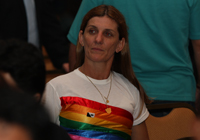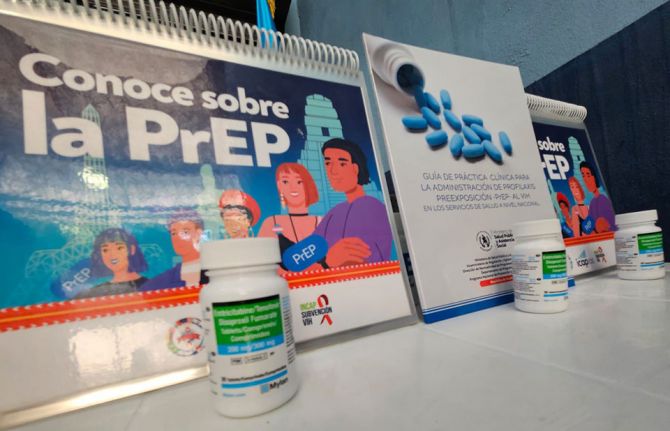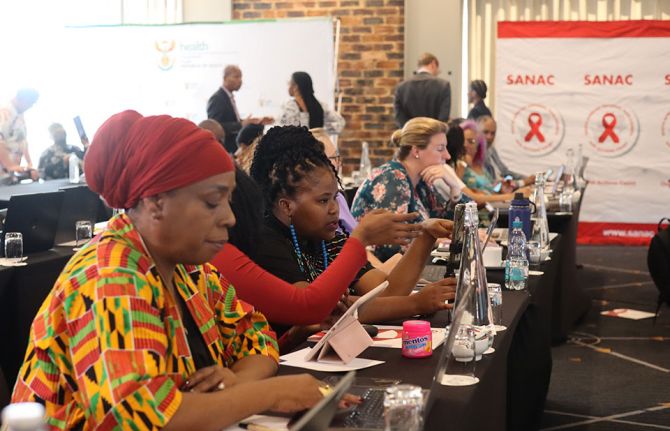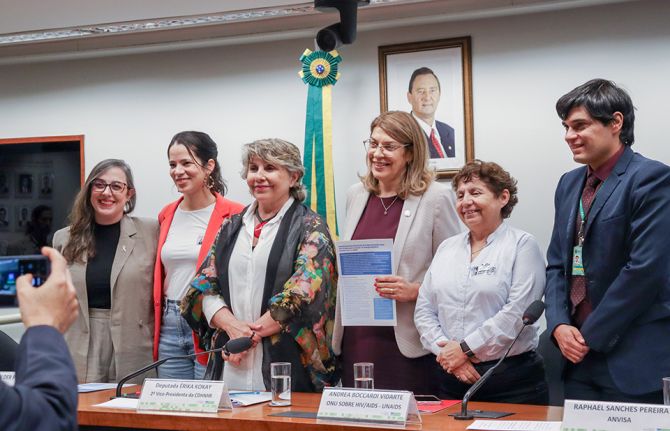
Feature Story
HIV prevention hampered by homophobia
13 January 2009
13 January 2009 13 January 2009
Aside from the individual pain homophobic attitudes inflict, the continuing stigma attached to same-sex relations is complicating hugely the task of slowing the spread of HIV. Credit: L. Tanabe, National STD/AIDS Programme, Brazil
Every two or three days a person is killed in Brazil in violence connected with his or her sexuality, according to Brazil’s oldest gay rights association, Grupo Gay da Bahia (GGB). In Mexico, the reported figure is nearly two a week.
Most of the victims are men who have sex with other men (MSM) - whether they are gays or bisexuals - or transgender people.
But if Brazil and Mexico top the table of violence against men who have sex with men in Latin America, this may be because rights groups there monitor the situation more closely than elsewhere in Latin America. Much violence simply goes unreported elsewhere, gay activist organizations say.
“Brazil and Mexico are the only countries which have a register, which keep track of the murders. That does not mean necessarily that there is more violence there,” says Arturo Díaz Betancourt of the Mexican National Council for the Prevention of Discrimination.
It is notable that when the United Nations Special Rapporteur on Extra-Judicial Killings made an official mission to Guatemala in 2006 his attention was drawn to a series of murders of gay and transgender people, and his subsequent report to the Human Rights Council stated “There has been impunity for murders motivated by hatred towards persons identifying as gay, lesbian, transgender, and transsexual. Credible information suggests that there were at least 35 such murders between 1996 and 2006. Given the lack of official statistics and the likely reticence if not ignorance of victims’ family members, there is reason to believe that the actual numbers are significantly higher.”
Many Latin American countries boast socially advanced legislation when it comes to defending sexual freedom and orientation. With law reform in Nicaragua and Panama over the past 12 months, there are now no states in Latin America which criminalize homosexual relations, for example.
Yet perhaps influenced by a lingering “machismo”, prejudice and discrimination continue to flourish, whatever the laws say. Latin America is widely regarded as having a long way to go to successfully counter homophobia, or “fear or hatred of homosexuals.”
“There is a real contrast between reality and theory. This is the developing region of the world with the highest number of laws against discrimination based on sexual orientation,” says Dr. Ruben Mayorga, UNAIDS Country Coordinator for Argentina, Chile, Paraguay and Uruguay.
Aside from the individual pain homophobic attitudes inflict, the continuing stigma attached to same-sex relations is complicating hugely the task of slowing the spread of HIV in a region where sex between men is a leading mode of HIV transmission, health experts say.
Stigma and homophobia increase the isolation of gays, bisexuals and transgender people making them more reluctant to come forward, be identified and get advice.
“Homophobia represents a threat to public heath in Latin America,” the Pan American Health Organization affirmed in a report. “This form of stigma and discrimination based on sexual orientation does not just affect the mental and physical health of the homosexual community, but contributes to the spread of the HIV epidemic.”
UNAIDS has long campaigned against discrimination whether against those infected by the HIV virus or against a person for his or her sexual orientation.
Main source of new HIV infections

Stigma and homophobia increase the isolation of gays, bisexuals and transgender people making them more reluctant to come forward, be identified and get advice. Credit: L. Tanabe, National STD/AIDS Programme, Brazil
The urgency in Latin America is underlined by official reports on the state of the HIV epidemic in Colombia, Ecuador, Bolivia and Peru where sex between men is acknowledged as being the main source of new HIV infections. HIV prevalence is far higher than in the general population with rates of between 10% and 20% in many Latin America’s main cities.
In its 2008 report to the UN General Assembly (UNGASS) on the state of the HIV epidemic, Brazil stated that MSM are 11 times more likely to be HIV positive than the population as a whole.
In parts of Central America, where there is major political and social resistance to recognising the rights of gays, lesbians and transgender people, HIV incidence rates amongst MSM are particularly high.
And the impacts of these high rates of HIV extend beyond men who have sex with men themselves. In Peru, for example, most women who get infected by the virus get it from men who have had sex with other men, according to a Health Ministry study, thus prevention among MSM is crucial for effective prevention of HIV transmission to women.
Prevention fails to keep pace
Spending on HIV prevention amongst MSM in Latin America is well below what is called for by the extent of the epidemic within that group. On average, less than 10% of the money spent on prevention goes into campaigns aimed specifically at MSM, according to UNAIDS.
In Bolivia, it was estimated in 2005 that fewer than 3% of MSM had access to prevention services, compared with 30% coverage for sex workers.
“All these years, prevention has not been carried out where it needs to be, which is where the epidemic lies,” said Díaz. “They have not worked with gays, with trans (gender people), on the contrary there is rejection and deep discrimination,” he said, referring to the situation across the region.
The explanation lies in a mix of political, cultural and even religious factors, rights activists and health officials say.
“Politically, MSM is not something to make a lot of noise about. In most countries and by many institutions it is not sees as a political gain,” says Mayorga.
Religious groups, whether Roman Catholic or evangelical, which regard sexual relations between people of the same sex as “sinful” have often strenuously opposed attempts to pay special attention to MSM.
“Governments are highly influenced by religious sectors that mobilise against policies that benefit gays, bisexuals or trans,” says Orlando Montoya, who works in Ecuador with ASICAL, an organization promoting the health of gays, other MSM and lesbians in Latin America.
However, it is hard to generalize. Some churches have been at the forefront of outreach to men who have sex with men and many local religious organizations in Latin America have responded to HIV with tolerance and compassion, including among the most marginalized populations.
Internationally overlooked
But it is not just a question of country governments not paying due attention to MSM. Latin America has not attracted the level of international investment in stemming HIV epidemics that has been seen in other parts of the world -- in Asia and in Africa.
To some extent, the region has been victim of the three “nots” when it comes to receiving international financing for its HIV efforts, Mayorga says. It is ‘not’ very populated, it is ‘not’ very poor and it is ‘not’ a very big epidemic.
Rules covering assistance by the Global Fund to Fight AIDS, Tuberculosis and Malaria, the principal international financing arm against the diseases, have worked against the region because they have tended to exclude middle and upper middle income countries, such as Argentina and Chile.
However, the Fund has recently agreed to study proposals for assistance for programmes in better-off countries facing concentrated epidemics with HIV prevalence rates of over 5 % in groups at risk, such as MSM, drug users, transgendered people or sex workers.
Renewing the focus
In the face of the persistent evidence of neglect, there are some positive signs in the region that MSM epidemics will be responded to with more adequate measures and policies.
In the past four or five years, Brazil and Mexico, and to a more limited extent Argentina and Colombia, have run campaigns against homophobia. These countries, together with others, have also sought to incorporate special MSM action into programmes to contain the spread of HIV.
The official programme “Brazil without Homophobia” was launched in 2004, with the aim of improving the service given to gays, other MSM and transgender people within state health institutions. It will also scale up coverage and the response to the HIV epidemic within these groups.
Peru has launched a national plan giving priority to prevention programmes for what are defined as “most-affected” groups – which include MSM, sex workers and prisoners. With financing from the Global Fund, the plan aims to extend prevention coverage to at least 25% of MSM and 50 percent of sex workers.
Similarly, Bolivia has drawn up a national plan to cut HIV infection rates by half by 2015, which includes campaigns to strengthen rights of MSM and transgender people and to combat discrimination and stigma.
Despite these promising developments, Latin America is still a long way from getting its MSM epidemics under control and homophobia and stigma remain significant stumbling blocks to achieving it.
Right Hand Content
Feature stories:
ICASA 2008: Men who have sex with men and HIV in Africa (07 December 2008)
MSM and the global HIV epidemic (31 July 2008)
Strengthening work with MSM in Africa (23 May 2008)
Global initiative to stop the spread of HIV among men who have sex with men (24 July 2007)
Press centre:
Criminalization of sexual behavior and transmission of HIV hampering AIDS responses (27 November 2008)
Publications:
Practical guidelines on HIV prevention
Men who have sex with men, HIV prevention and care (pdf, 638 Kb)



